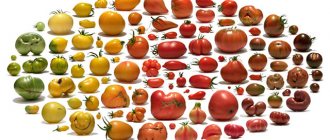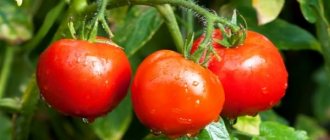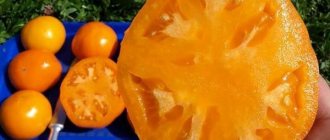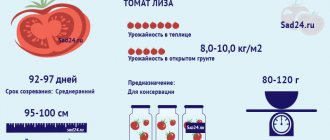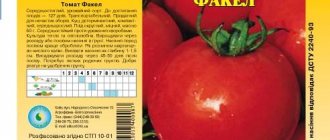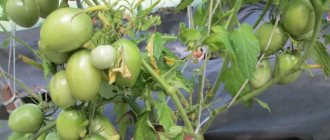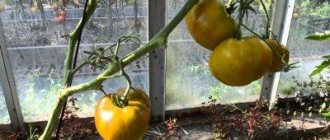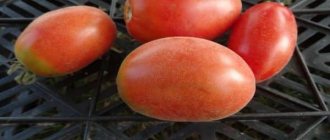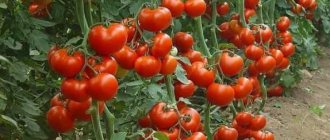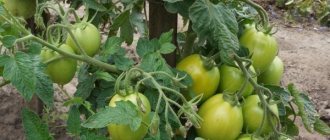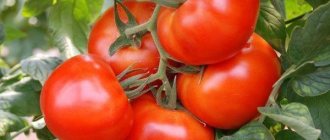Diseases and pests
Phytophthora Prevention:
Ways to fight:
| |
| Apical rot Prevention:
Ways to fight:
| |
| Colorado beetle Prevention:
Ways to fight:
|
Characteristics
Tomato hybrid 6 Tarasenko
The main advantages of “New Koenigsberg” include:
- resistance to temperature changes;
- high immunity to diseases;
- good yield;
- excellent taste.
Among the shortcomings, many people notice that “New Koenigsberg” requires careful attention to watering and fertilizing. The main feature of this type of tomato is the growth of the bush and its resistance to diseases. They also note the possibility of growing in open ground in the middle zone without loss of yield.
Fruit characteristics:
Fruits that have reached varietal maturity are quite large, about 300 g, but can be larger, reaching 500-600 g. They are slightly elongated in shape. The color of the fruit depends on the variety, so “golden” is yellow, and “red” is bright red, and New Koenigsberg is also pink. The number of chambers in the fruit is 5-6, the dry matter content is up to 5%. The harvested crop can be stored for a long time and tolerates transportation well, which has earned the attention of farmers who grow tomatoes for sale.
You can compare the weight of fruits with other varieties in the table below:
| Variety name | Fruit weight |
| New Koenigsberg | 300 |
| Bobcat | 180-240 |
| Russian size | 650-2000 |
| Podsinsky miracle | 150-300 |
| American ribbed | 300-600 |
| Rocket | 50-60 |
| Altaic | 50-300 |
| Yusupovsky | 500-600 |
| Premier | 120-180 |
| Honey Heart | 120-140 |
The fruits of this type of tomato are excellent fresh. Not suitable for whole-fruit canning due to the size of the fruit. Very well suited for barrel pickling. Juices and pastes are made from the red variety of these tomatoes; thanks to the combination of acids and sugars, they have a pleasant taste.
Not only the southern regions, but also areas of central Russia are suitable for cultivation. It can also be grown in greenhouse shelters in the northern regions; this does not significantly affect the yield. It is for these properties that this type of tomato is loved by many summer residents.
"New Koenigsberg" is a tall plant, so it needs a garter. Its branches are strewn with heavy fruits; they definitely need supports. The bush is formed into two stems. Responds very well to complex feeding.
Grow in open and closed ground
The crop is grown by seedlings. Sowing of tall tomatoes begins 60-65 days before transplanting to the main growing site. The seeds are pre-treated with a fungicide, for example Fitosporin.
The procedure will prevent fungal infection of tomatoes at the seedling stage. And humic acid in the composition will stimulate germination. After a few weeks, the treatment can be repeated.
The soil and planting containers are also pre-disinfected. The soil is loosened, large inclusions are removed and placed in common or separate containers. For planting it needs to be moist, but not soggy. When a lump of earth is formed by squeezing in your hand, water should not drain.
The soil for sowing is leveled, shallow furrows are marked with a distance of 3 cm. The seeds are buried no more than 1 cm. The planting containers are kept in a place with a temperature above room temperature until germination. When sprouts appear, the container is moved under lamps with a special lighting spectrum.
Important! When straightened, the cotyledonous knee of an indeterminate variety will be longer than that of low-growing species, which is considered the norm. Seedlings are transferred to open ground or greenhouses from April to May when positive night temperatures exceed 10°C.
The soil for planting must be at least 15°C at a depth of about 20 cm. When the soil cools, the plants stop growing and may get sick. Therefore, in the middle zone and colder regions, it is recommended to plant the crop in raised or warm ridges
Seedlings are transferred to open ground or greenhouses from April to May when positive night temperatures exceed 10°C. The soil for planting must be at least 15°C at a depth of about 20 cm. When the soil cools, the plants stop growing and may get sick. Therefore, in the middle zone and colder regions, it is recommended to plant the crop in raised or warm ridges.
Tomatoes are placed at a distance of at least 50 cm
It is important that in adulthood the plants do not touch their leaves. Before planting, the holes are watered abundantly and, if necessary, filled with complex fertilizer.
When adding additives, they are thoroughly mixed with the soil so that there is no direct contact with the root system. The tomato is planted without deepening, sprinkled with soil and lightly kneaded.
Plants are immediately tied up after transplantation.
Hilling - adding soil to the trunk - stimulates the formation of additional roots
Watering for plants is carried out evenly, the first - a week and a half after transplantation. Use only warm water and moisture along the root zone. At the same time, they try not to touch the vegetative parts of the plant. Mulching also allows you to maintain soil moisture for a longer period and eliminates crust on the surface.
Characteristics and description of the variety
Tomato budenovka
The variety is a hybrid; in its production, Siberian breeders used two varieties. But at the same time it belongs to the so-called pure varieties. Ask what the difference is between them - hybrids cannot collect their own seeds for planting next year. Therefore, you have to purchase them again. Whereas a pure variety allows you to do this, and with a little skill you will have your own seeds every year.
From one root two stems grow, the structure of which is quite dense; many brushes are formed on the stems. Each bunch will please the gardener with 5-6 tomatoes weighing 300-800 grams. the first ones can be removed 110-115 days after planting the seeds. This allows us to classify this tomato as mid-season.
Koenigsberg tomatoes are distinguished by a powerful system of roots that go deep into the ground.
The fruits have an oblong shape; if you look closely, you can see their resemblance to a stylized image of a human heart, with a somewhat pointed tip. They are red in color and protected by a skin with a dense texture, making them easily withstand long-distance transportation.
The fruit pulp is fleshy, with a small juice content. Inside they are divided into five chambers for seeds. Those who already grow this variety on their plot immediately warn that due to the large size of the fruits, it is impossible to pickle the whole fruit. But in a salad or fresh, they are simply delicious. And the sauces and juice made from them have a wonderful taste.
In addition, gardeners note other advantages:
- Excellent resistance to heat and cold during sudden temperature changes. No wonder it was specially bred for the regions of Siberia;
- Has high resistance to most pests and diseases;
- Shows ease of care.
Regarding the last point. Yes, the variety feels great on any soil, but if the soil is fertile, then the harvest will be greater. So there's no point in experimenting.
Description of tomato variety Koenigsberg
Tomato azoyushka
The Koenigsberg tomato took its place in the State Register of the Russian Federation in 2005 and is recommended for open ground in all climatic regions of the country. Of course, it can also be grown in greenhouses, but there is no particular point in taking up space once again with a plant that can withstand cold, drought and all kinds of weather vagaries. The variety was bred by breeder V. Dederko in the Novosibirsk region, which indicates its special resistance to unfavorable climate. The variety is also highly resistant to major diseases.
This tomato grows as a very large bush that can reach a height of even two meters. Of course, such plants require mandatory staking and shaping, but the variety generously pays for care with very high yields: two buckets from one bush is not the limit. Due to the high growth vigor, Koenigsberg has to be planted quite freely, so the yield per square meter does not seem prohibitive, but the usual 20 kg is not a small figure at all.
The variety belongs to indeterminate plants, that is, the growth of the bush is, in principle, unlimited, so in the process of formation it has to be artificially limited. The bushes are beautiful, covered with rather large leaves of light green color. The roots are powerful, go deep down and spread to the sides. The fruits grow quite far from the ground: the very first inflorescence is located only above the 12th leaf, and the following ones - every three leaves. There are 5-6 tomatoes in the brushes.
In terms of ripening time, the variety is classified as mid-season, that is, harvesting occurs no earlier than the beginning of August. The fruits are cylindrical, with a pointed tip, very dense, smooth, without seams, perfectly stored and transported. The mass of tomatoes of the red variety is at least 150 g, but mostly more than 200 g, up to 300 g, and sometimes more, and the largest specimens grow in the lower part of the bush. Why did the word “red” appear? The fact is that Konigsberg fruits of various modifications are known. They are not classified as different varieties, considered subspecies:
- red - considered the leading, most common subspecies, the fruits have a classic bright red color, a shape similar to an eggplant;
- golden - tomatoes are colored yellow-orange due to the high content of carotene (popularly called “Siberian apricot”); this subspecies has slightly lower yields, but very high resistance to late blight;
- striped - has a basic red color, but is covered with yellow stripes; the fruits are somewhat smaller in size (up to 200 g), so they can easily be placed in three-liter glass jars;
- pink - a relatively young subspecies, has increased productivity;
- heart-shaped - a subspecies that bears fruit with especially large tomatoes of raspberry color and shape that differs from the rest.
Any of the Königsberg varieties are distinguished by their excellent taste and strong aroma of fruits, the purpose of which is universal: they are also suitable for salads, and for various types of processing, but only small tomatoes are suitable for whole-fruit canning. Therefore, mostly the excess harvest has to be processed into tomato sauce, juice or paste. Those tomatoes that are placed whole in a jar do not crack during canning and retain their shape and color.
Agricultural techniques
The soil in the selected area is loosened and fertilized. Immediately before planting, the soil is moistened. It is necessary to maintain the density of plantings - 3 bushes per 1 sq. m so that each plant has sufficient area to grow. The optimal interval between seedlings is within 35-40 cm.
On a note! During the adaptation period, it is recommended that seedlings make shelter from a cut plastic bottle.
Agrotechnical techniques for caring for the Koenigsberg tomato do not differ from other vegetable crops. Watering is carried out, depending on the drying of the soil, approximately once a week. In rainy times there is no need for it.
Loosen the soil in the root zone weekly to improve root aeration. Weed the beds to prevent overgrowing of weeds. Mulching is carried out twice a month. Sawdust, peat, and hay are used as mulch.
To improve self-pollination during flowering, the bushes are slightly shaken. The lower leaves on the bush are removed to ensure ventilation of the root zone. 1-1.5 months before the end of the growing season, the top of the shoot is pinched and excess flowers are picked off.
The bush should be sprayed monthly with a solution of 10% potassium nitrate to prevent infection. Crushed eggshells are added to the holes, which replenishes the calcium reserves needed by the plant.
Landing
You can plant tomato seedlings at the end of March, or 55-65 days before transplanting into the ground. Preparation for sowing begins with the soil. Soil for seedlings is available in stores, but you can make it yourself by mixing equal parts of soil from the garden, peat and humus, and then adding river sand calcined in an oven. Then add a little superphosphate and about a glass of wood ash to each bucket. The finished mixture is poured with boiling water in which 1% potassium permanganate is dissolved.
It is recommended to sow tomato seeds in such soil not immediately after cooling, but after 2-3 days, so that beneficial microflora has time to form in it.
Seeds are prepared in several stages:
- Etching. Prepare a 1% solution of potassium permanganate or a slightly weaker one and place the seeds there for an hour. Then washed with water.
- Stimulation. Prepare a solution of Zircon or Epin according to the instructions and treat the dried seeds.
- Warming up. The seeds are wrapped in a cloth and placed on a central heating radiator or on a lamp shade (if it is not very hot) for 3-5 hours. Too high temperatures are contraindicated!
- Germination. Place the seeds on a cloth, place it on a saucer and moisten it so that the seeds peek out a little from the water. Change the liquid daily until the sprouts hatch.
Soil is laid out in pre-disinfected boxes, in which grooves are made 1-1.5 cm deep. They should be 3 cm apart from each other. The sprouted seeds are placed in the grooves at small intervals, carefully taking them with tweezers so as not to break the sprouts. Just carefully sprinkle with a layer of soil and spray with water from a spray bottle instead of watering.
The boxes are wrapped in film or covered with glass. Until sprouts appear, keep on the windowsill at a temperature of +20-25.
The film is raised every day for 15-20 minutes for ventilation.
When the seeds sprout, the sprouts should spend the first three days of their life at a temperature of +16 to harden and prevent stretching. Then at night they are provided with +18 degrees, and during the day - +22.
You can feed the seedlings once or twice with a special fertilizer or a weak urea solution.
Before transplanting to the garden, the bushes are hardened off for 10-12 days. They are put outside first for an hour a day, then increasing this period over time.
The soil on the site should be loose, well fertilized with rotted manure (not fresh!), treated with a solution of potassium permanganate or a weak solution of copper sulfate against fungi.
Nightshade predecessors are not suitable for tomatoes: other tomatoes, peppers, potatoes, eggplants. It is better to plant them in the garden after cucumbers, pumpkins, zucchini, cabbage, carrots, onions, and legumes.
For 1 sq.m. plant 3 plants.
Description of the Koenigsberg tomato variety with photo
The Koenigsberg tomato is an indeterminate type, which means unlimited plant height. During the summer, the stems grow up to 1.8 m in protected soil, and 1.5 m in open ridges. At the end of summer, the growth point of the plants is pinched to stop the appearance of a new ovary and direct energy to the ripening of the fruits. The inflorescences of the variety are simple, the first appears high above the 12th leaf, the next ones sequentially - after three.
The growth of stems in the crop is limited above 7-8 brushes
The leaves of the variety are large, light green in color with barely noticeable pubescence. The root system is powerful and goes deep into the soil. In order for the plants to have enough nutrition, they are planted in no more than 3 units. per 1 sq. m.
The Koenigsberg tomato was created in the climatic conditions of Siberia, therefore it is suitable for both warm and cold regions. Designed for outdoor cultivation in personal garden plots, as well as small farms.
Important! The Koenigsberg tomato shows high fruit set in different weather conditions.
A vigorous bush must be formed into 1-2 stems, and the remaining side shoots-stepchildren must be removed in a timely manner. To support the stems, as they grow, they are tied to a support using a loose loop or twisted around a string.
If you have difficulty determining whether a Koenigsberg tomato is a variety or a hybrid, you can confidently say that it is a variety. Breeders managed to develop a crop with high rates of adaptability to temperature fluctuations, resistance to diseases and productivity.
Description of fruits
The Koenigsberg tomato has elongated red fruits. There is a variety called Golden Koenigsberg, the fruits of which are yellow in color. Tomatoes are cylindrical in shape with a pronounced spout.
Tomatoes are formed in dense clusters of 5-6 pieces.
Both shades of the Koenigsberg variety are rich and bright. The tomatoes are smooth, with an average weight of 150-230 g, some specimens reach 300 g. Larger ones grow in the lower part of the bush than in the upper. Number of nests – 3-4 pcs. In Siberian conditions, the yield of ripe fruits is 56%. Tomatoes ripen well indoors. The taste is excellent.
Tomatoes called Koenigsberg pink, orange, striped with corresponding colors are also produced by agro. Varieties have different characteristics.
Growing and care
The Koenigsberg tomato variety requires standard care.
- Watering. In hot, dry weather, plants are watered abundantly at the root. High-quality watering is especially important at the time of flowering and fruit filling. During the ripening period, it is reduced to a minimum or stopped altogether. Excessive moisture will cause tomatoes to crack.
- Feeding. About 2 weeks after planting, at the time of intensive growth of the vegetative mass, experienced gardeners feed the tomatoes with a fermented infusion of nettle or mullein. This promotes the development of strong, durable bushes. The next feeding is carried out at the time of laying and development of the fruit cluster. For this, a mixture of urea, superphosphate and potassium sulfate is used. Fertilizers are diluted in full accordance with the attached instructions.
- Formation. The Koenigsberg tomato variety requires the mandatory formation of bushes. This helps limit the development of leaf mass and normalize the number of brushes. Tomato Koenigsberg is formed into 1 stem, less often into 2.
- Stepchildren are removed after they reach a length of 3-4 cm. To ensure painless removal and prevent regrowth, stumps should be left. Untimely planting significantly reduces the yield and delays ripening. A large number of leaves reduces ventilation and creates favorable conditions for the development of fungal diseases and various rots.
- The Koenigsberg tomato is a giant variety, so at the end of August its apical growth point is removed and part of the lower leaves are removed. This speeds up the ripening of tomatoes. According to reviews, those who planted and grew this variety should remove no more than 2-3 leaves at a time. Otherwise, due to a sharp decrease in moisture evaporation from the leaves, the tomatoes begin to crack.
Tomatoes are harvested in dry, warm weather. Fruits at the stage of milky ripeness and completely green are collected separately. They can be used for further ripening. To do this, they are laid out in a dry, dark and warm place. Stored tomatoes should be sorted periodically, selecting ripened and rotten tomatoes.
Growing Königsberg tomatoes is not much different from standard methods of growing tomatoes. The variety has good taste, is not very demanding and deserves attention.
Tomato variety Koenigsberg: photos and review of other popular varieties
The tomatoes grown can be of completely different varieties. Each of them has its own maximum yield volume, type and height of bushes, weight, size and shape of fruits, and the percentage of dry matter in them.
Koenigsberg tomatoes are suitable for growing both in open ground and in a greenhouse
Popular varieties for growing on balconies, in greenhouses and in open ground include:
- Giant New. This variety belongs to the indeterminate varieties, that is, the growth of the tomato bush is not limited to certain sizes. Tomato fruits are round, slightly flat with juicy pulp. The weight of the fruit varies from 450 to 700g.
- Pink flamingo. A variety of pink tomatoes. The fruits grow weighing up to 220g;
- Sugar bison. The growth of the bush can reach 1.5-1.8 m. The tomato is shaped like a heart. The weight of one average fruit varies from 70 to 110g. This variety is most suitable for growing in greenhouses and greenhouses.
- El Dorado. Medium fruits with sweet pulp can reach a weight of 200-210g.
- Gold autumn. A relatively new variety of tomatoes. The bush reaches 70 cm in height. The fruits are orange in color. This variety of tomatoes is high-yielding and is well suited for planting in open ground.
- Rapunzel. A characteristic feature of this variety is its long fruiting clusters, which can hold up to 40 cherry-type fruits. The fruits have a rich red color. It is early ripening, that is, from the moment of planting the seedlings to the ripening of the fruits, on average, 75-76 days pass.
- Koenigsberg. A relatively new variety of tomatoes, bred by domestic Siberian breeding scientists. Tested in harsh climatic conditions. Ideal for growing in greenhouses and greenhouses, as well as in open ground. Subspecies of this varietal line can be classified as varieties of red, pink and yellow tomatoes. Depending on the subtype.
Among the determinant varieties, one can highlight the variety “My Joy” F1. It is an early ripening variety of tomatoes. From the moment of planting the seedlings to the ripening of the fruits, an average of 92-96 days pass. Well suited for growing in open ground or in a greenhouse. The height of the bushes can reach 100 cm. During the growth of the bushes, a garter is required. Tomato fruits are round and red in color. Fruit weight is from 80 to 160 g. The tomatoes are juicy and fleshy. “My Joy” gives a rich harvest and is a heat-resistant variety. In addition, these tomatoes are resistant to tomato diseases such as fusarium and mosaic.
Let's look at the Koenigsberg variety in more detail.
How to grow seedlings
To obtain a high-quality and abundant harvest of tomatoes, the seedling method of planting vegetables is used. Work on growing seedlings begins in early spring.
Soil preparation
Tomatoes grow and develop best in light, loose black soil. An excess of fertilizers and fertilizing for vegetable crops is not required. For planting seedlings, turf soil mixed with peat and humus is suitable. A small amount of ash is also added to the mixture.
Warming up the seed material
High-quality seeds, as a rule, do not require additional processing. But for regions with cold climates, planting material is heated. This procedure quickly awakens the seed material and helps accelerate plant growth.
To warm up, use sunlight, ultraviolet lamps, electric dryers or water heated to 60 degrees.
- The seed material is kept under the sun for up to 5 hours.
- They are heated for 50 seconds using an ultraviolet lamp.
- In electrical appliances, the seeds are heated at a temperature of 40 to 60 degrees for 3 hours.
- Keep the seed in hot water for no more than 20 minutes.
Germination of seeds
To increase the growth rate of tomatoes, the seeds are germinated before planting. To do this, the prepared seed material is wrapped in a damp cloth and left for 2–3 days.
Sowing
Tomatoes are planted in small containers with fertile soil mixture.
- Place the seeds at a distance of 1 centimeter from the soil surface, leaving 2 to 4 centimeters between the plants.
- Before emergence, containers are kept at a temperature of at least 25 degrees.
- As soon as the sprouts appear, the tomatoes are transferred to a room with a temperature of no more than 18 degrees for 3-4 days.
- Next, the seedlings are grown under normal conditions.
- Tomato picking is done 10–14 days after emergence. Now the plants are planted in separate containers or large boxes.
Important! Seedlings need plenty of sunlight, periodic watering and fertilizing.
Hardening
The seedlings are hardened off 2 weeks before planting in a permanent place of growth. To do this, the plants are taken outside for 2–3 hours every day or sent to a cool room.
Application of growth accelerators
Growth accelerators are used in the process of preparing seed material for planting. This procedure will help the seeds awaken and germinate faster.
Features of cultivation
Seeds for seedlings are sown in early March, treated with a weak solution of potassium permanganate and, if desired, growth stimulants, for example Zircon . They dive when they grow to 3 true leaves. Seedlings are planted in the ground 50 days after emergence.
Important! Many gardeners are worried about the appearance of Koenigsberg seedlings, as they look lethargic and lifeless. However, there is no need to worry; this tomato variety is characterized by slight lethargy.
More information about growing tomatoes is described in the article: Technology of growing tomatoes. Secrets of planting and care
About how to properly form a bush if you grow tomatoes in a greenhouse: How to properly plant tomatoes in a greenhouse: diagram of bush formation, care features, photos and videos
In open ground: How to properly tie tomatoes in open ground: the best methods, step-by-step photos and video instructions Watch the video! Tomato Koenigsberg golden - delicious, beautiful
Characteristics of the Koenigsberg tomato
The Koenigsberg tomato is a tall crop with an average ripening period. The seeds have a high germination rate. In order to speed up the germination process, increase immunity and establishment, it is recommended to use plant growth and development stimulants. The culture is suitable for growing in open ground. The bushes are demanding when it comes to shaping and fertilizing.
Koenigsberg tomato productivity and fruiting
The yield of the Koenigsberg variety depends on the place of cultivation and the nutritional value of the soil. In open ground it can range from 4.6 to 20 kg per 1 sq. m. The ripening period of the crop is average, fruiting begins in the fourth month after sowing. Fruit ripening is consistent.
Area of application of fruits
Koenigsberg tomatoes are suitable for various types of processing. The fruits make equally tasty tomato juice, lecho, adjika, and ketchup. Tomatoes are added to the borscht dressing. They are used fresh in salads, where their pleasant taste and aroma are well expressed. Tomatoes also have excellent shelf life and transportability.
Resistance to diseases and pests
Koenigsberg tomatoes are disease resistant. But given the ripening period in the second half of summer and the duration of fruiting, it is necessary to carry out preventive spraying against late blight.
Reviews of the Koenigsberg variety
Review: An excellent variety, I recommend it for planting (author: tatvit source: otzovik.com)
Reviews about Koenigsberg tomatoes are quite contradictory, which is usually associated with buying seeds on the market. When you buy second hand, it is difficult to be sure of the variety. Therefore, it is better to purchase seeds at garden centers or online stores.
Tomatoes of the Koenigsbeng variety are sold by the online stores “Ural Summer Resident” and “Siberian Garden”.
Among the advantages, vegetable growers note good keeping quality, wonderful taste and abundant fruiting. The disadvantages put forward are such features of the variety as an extended period of fruit ripening and poor yield in open ground in the northern regions.
Choosing the right variety is a serious matter. Therefore, weigh for yourself all the “pros” and “cons” of the tomato with the German name Königsberg and, by trial and error, get large yields.
Diseases and pests
The variety is immune to fungal infections, but can still become infected with them, so it is important to prevent their occurrence and timely treatment. Preventive measures include maintaining the humidity level for the bushes, ventilating greenhouses and treating with special preparations
Preventive measures include maintaining the humidity level for the bushes, ventilating greenhouses and treating with special preparations.
Bushes can be attacked by Colorado potato beetles and whiteflies, which can be controlled using insecticidal preparations or folk remedies.
Tomato "Koenigsberg": description of the variety
| Variety name | Koenigsberg |
| general description | Mid-season indeterminate variety |
| Originator | Russia |
| Ripening period | 110-115 days |
| Form | Elongated, cylindrical with a small nose |
| Color | Red |
| Average weight of tomatoes | 300-800 grams |
| Application | Universal |
| Productivity of the variety | 5-20 kg per sq.m |
| Features of cultivation | Standard agricultural technology |
| Disease resistance | Resistant to major diseases |
"Konigsberg" is an independent variety of tomatoes, which has absorbed all the best qualities. The “Konigsberg” bush is considered indeterminate in its growth type (i.e., has no end point of growth), up to 2 m in height, usually formed into 2 powerful stems with many brushes. Each cluster contains about 6 fruits. Does not form a standard.
The rhizome is powerful, directed deep down. The leaves are large, “potato-like,” dark green with slight pubescence. The inflorescence is simple (ordinary), formed for the first time above the 12th leaf, then goes through every 3 leaves. Pedicel with articulation. In terms of ripening time, it is mid-season - harvesting is possible 110-115 days after planting the seeds.
Well resistant to many diseases and pests. “Konigsberg” tomatoes have been developed for open ground; they behave well in a greenhouse and do not wither. Productivity is high. From 5 to 20 kg per 1 sq. m. According to reviews from gardeners, it is possible to harvest three buckets per bush.
The variety has many advantages:
- high productivity;
- excellent taste;
- heat and cold resistance;
- resistance to diseases and pests;
- unpretentiousness.
There are no disadvantages with proper care. The size of the fruit is impressive, and at the same time it has a pronounced “tomato” taste and aroma.
You can compare the yield of this variety with other varieties in the table:
| Variety name | Productivity |
| Koenigsberg | 5-20 kg per sq.m |
| Thick handsome man | 10-14 kg per square meter |
| Premium | 4-5 kg per bush |
| Marissa | 20-24 kg per sq.m |
| Gardener | 11-14 kg per square meter |
| Katyusha | 17-20 kg per square meter |
| Debut | 18-20 kg per square meter |
| Pink honey | 6 kg per bush |
| Nikola | 8 kg per sq.m |
| Persimmon | 4-5 kg per bush |
On our website you will find a lot of useful information on how to properly grow tomato seedlings. Read all about planting seedlings at home, how long after planting the seeds sprout and how to water them correctly.
And also how to grow tomatoes in twists, upside down, without soil, in bottles and using Chinese technology.
Variety varieties
There are 4 varieties of the Koenigsberg variety, which have gained recognition among gardeners.
Gold
Mid-season, high-yielding, suitable for growing in open ground and greenhouses.
| Characteristics of the bush | The average plant height is 1.5 meters. |
| Fruit characteristics | The fruits are elongated, collected in clusters of 5-6 pieces with an average weight of about 300 grams. The first fruits are larger, their weight is 450-500 grams, the weight of the latter does not exceed 250 grams. The pulp of tomatoes is dense, juicy, with a small amount of seeds. The taste of golden Koenigsberg is rich and sweet. The fruits are used for fresh consumption and for whole-fruit canning. |
Cordate
Characterized by medium ripening periods. Koenigsberg cordate has increased resistance to major tomato diseases. Tolerates adverse weather conditions well.
| Characteristics of the bush | The largest variety of Königsberg. The growth type is indeterminate. |
| Fruit characteristics | The fruits are deep pink in color with a slight raspberry tint. With proper agricultural technology and timely care, the average fruit weight reaches 1 kg. The fruits are fleshy, sweet, with a rich tomato taste. Tomatoes are used for preparing tomato juice and rolling preparations. |
Pink new
Mid-season variety of amateur selection. Valued for the good set of tomatoes in closed ground conditions. From the moment the shoots appear until the first tomatoes ripen, 100-110 days pass.
| Characteristics of the bush | Bushes of unlimited growth type, up to 1.8 meters high. |
| Fruit characteristics | The fruits are pink, pepper-shaped, weighing about 200 grams. The pulp is dense, juicy, excellent for various types of canning. If agricultural techniques are followed, yields reach 4 kg per bush. |
Striped
According to the stated characteristics and description of the variety, the Koenigsberg striped tomato is mid-season. The variety is valued for its high yields and original fruit color.
| Characteristics of the bush | Indeterminate type of growth. The Koenigsberg striped tomato variety is used for growing in greenhouses. |
| Fruit characteristics | Tomatoes are characterized by a somewhat cylindrical shape and have a smooth surface. At the stage of milk maturity they are green, when fully ripe they are red with characteristic longitudinal stripes of yellow color. The average fruit weight is 250-300 grams. The fruits are suitable for preparing fresh salads and canning. |
Advantages and disadvantages of the variety
This series of tomatoes can be called one of the best in Siberian selection, the main thing is to buy seeds from trusted suppliers.
Advantages:
- excellent taste (all types of varieties);
- ease of care;
- resistance to diseases and pests;
- resistance to adverse weather conditions;
- good yield regardless of region;
- high keeping quality;
- suitability for transportation;
- versatility of using fruits (fresh, canned, marinades, preparing sauces, juice, paste).
No shortcomings were identified in Koenigsberg, but we must remember that a high tomato yield is obtained only if the basic rules of agricultural technology are observed.
Characteristics and description of the variety
- The variety is indeterminate. What does it mean - the bush grows without having a final point. It needs to be formed. The most profitable option for creating high yields is to leave two stems.
- The variety has a very powerful root system that grows deep into the soil. Such roots enable the development of a massive aerial part.
- The brushes actively and evenly form the fruit. One brush can produce 6-7 tomatoes.
- "Konigsberg" has a medium-early ripening period. So, you will get your first harvest approximately 110-115 days after planting the seedlings.
- The variety was prepared for cultivation in open ground, which the breeders managed to do. But even in greenhouse conditions and under film, tall bushes do not wither. That’s why the yield is high in both places.
- The Koenigsberg tomato tolerates all disease attacks well. Also copes well with weather adversity. He is not afraid of the hot sun, temperature changes, or coolness.
- From one square meter you can collect a minimum of five kilograms, a maximum of more than 20 kg of fruit. As the experience of experienced gardeners has shown, one bush of the Koenigsberg variety can produce three buckets of tomatoes.
- Tomatoes have high taste, a delicate tomato aroma, dense and fleshy pulp. They can be consumed fresh, in the form of winter preserves, juices and sauces.
- This variety is unpretentious in terms of agricultural technology and soil. But with proper care there will always be a greater yield.
- A separate advantage of the variety is its fruits. They won the hearts of many summer residents in our country and not only. It's all about the heavy weight, which can reach up to 800 grams, but more often 300-400 grams, which is also a lot. Tomatoes also have an excellent taste, pleasant texture, delicate aroma, dense skin, which, despite its mass, does not crack. The shape of tomatoes is somewhat similar to a heart, with the tip slightly elongated. The color of ripe tomatoes is rich red.
- The tomato can be grown for sale, as it can easily withstand long-term storage and transportation.
If we talk about the disadvantages, then it is that it is impossible to obtain a similar hybrid yield, and large fruits are not suitable in their entirety for winter preservation. But you must admit, this can hardly be considered a significant disadvantage.
Bush care
Tomatoes "New Koenigsberg" are tall plants, so they need to be tied to a support or trellis. The bush must be formed into two stems. Since the branches are strewn with heavy and large fruits, they must be supported with pegs.
Activities for caring for bushes of the “New Koenigsberg” variety consist of the following:
- Regular watering;
- Loosening the soil in the beds;
- Weed removal;
- Fertilizing 2-3 times per season with organic matter and complex mineral fertilizers.
